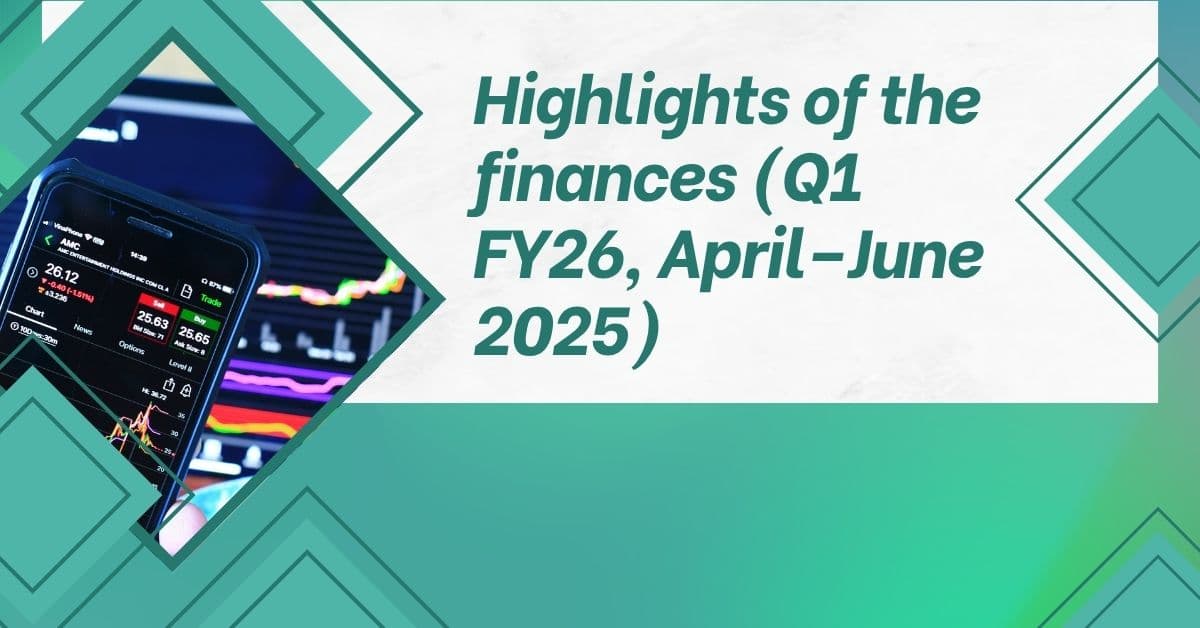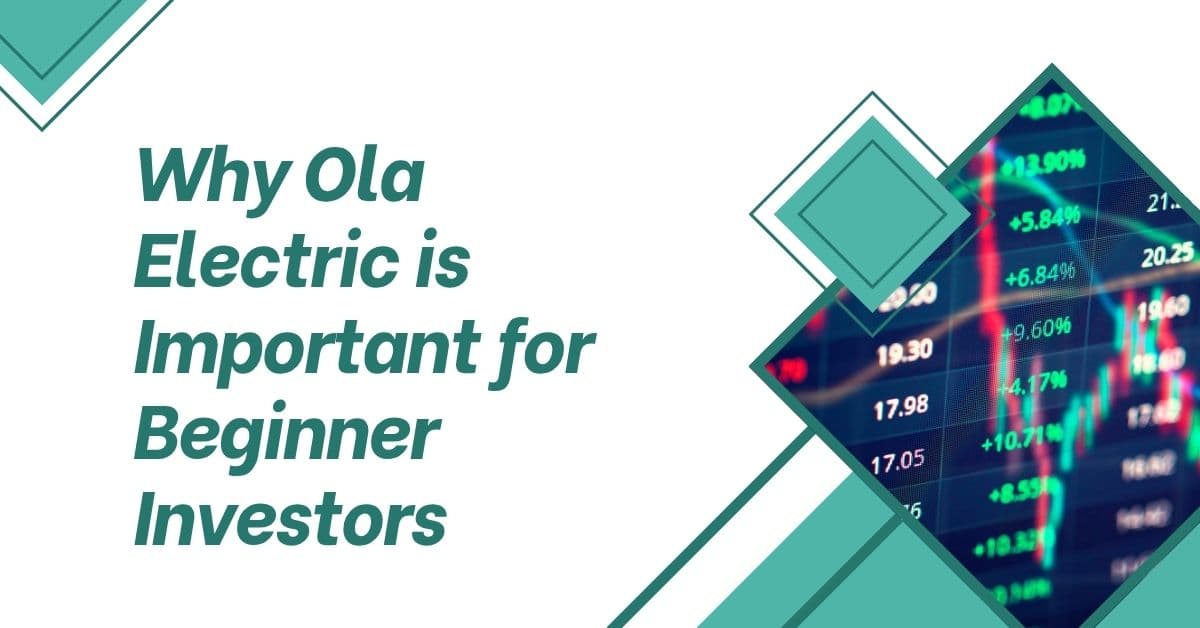Ola Electric Share Price NSE: India’s top producer of electric two-wheelers (E2Ws), Ola Electric Mobility Ltd., is spearheading the nation’s electric vehicle (EV) revolution. Ola Electric (NSE: OLAELEC) has jumped 19.75% since its Q1 FY26 results, which showed a narrower net loss of ₹428 crore and sales of ₹828 crore [Moneycontrol]. As of July 14, 2025, the company’s share price was trading at about ₹47.67. Ola Electric is a thrilling chance for beginner Indian investors to put money into a rapidly expanding industry on a small scale. However, cautious financial planning is necessary because to its volatility, continuous losses, and high debt levels. This detailed guide examines Ola Electric’s share price outlook, the reasons it’s attractive but risky for beginners, and realistic low-cost investment techniques to manage its potential in 2025.
Ola Electric: An Overview
Ola Electric Mobility Ltd. was established in 2017 and has its headquarters in Bengaluru. With a 31% market share, it is the biggest E2W maker in India. By FY26, the business intends to introduce bikes (Diamondhead, Adventure, Roadster, and Cruiser) in addition to electric scooters such the Ola S1 Pro, S1 Air, and S1 X. Operating out of its Ola Futurefactory in Tamil Nadu, Ola Electric is developing its unique Bharat Cell battery technology and producing in-house parts such as motors, vehicle chassis, and battery packs. Its technological advantage is further strengthened by the recent release of MoveOS 5 software, which improves vehicle performance, dependability, and range [Tickertape].
Ola Electric is well-positioned to benefit from India’s expanding EV industry, which is expected to grow at a 25% CAGR through 2030 [Economic Times], with 68,192 car deliveries in Q1 FY26 and an emphasis on direct-to-consumer (D2C) sales.
Highlights of the finances (Q1 FY26, April–June 2025)

- Revenue: ₹828 crore, down 49.64% year-over-year from ₹1,644 crore in Q1 FY25 but up 35.52% from ₹611 crore in Q4 FY25.
- Net Loss: The net loss was ₹428 crore, which was less than the ₹347 crore in Q1 FY25 but better than the ₹870 crore in Q4 FY25.
- EBITDA margin: The vehicle business had positive EBITDA in June 2025, and the EBITDA margin improved from -90.6% in Q4 FY25 to -28.6%.
- Market Cap: With a 52-week range of ₹39.60 to ₹157.40, the market capitalisation is ₹20,951.44 crore.
- Debt: With a debt-to-equity ratio of 34%, plans call for raising ₹1,700 crore.
- Promoter Holding: As of March 2025, Promoter Holding was steady at 36.78% [Screener].
Despite continuous losses, investor confidence has been reflected in a 19.75% gain in share price due to Ola Electric’s operational improvements, which include a 32.7% increase in vehicle deliveries and a predicted 35% gross margin by Q2 FY26 [Business Standard]. However, a high price-to-book ratio of 4.05 and negative earnings per share (EPS) of ₹-5.48 suggest a premium valuation, which puts investors at risk.
| Metric | Value |
| Share Price (14 July,2025) | ₹47.67 |
| 52-Week Range | ₹39.60-₹157.40 |
| Market Cap | ₹20,951.44 crore |
| P/E Ratio | Negative (EPS: ₹-5.48) |
| Price-to-Book Ratio | 4.05 |
| Debt-to Equity Ratio | 34% |
| Promoter Holding | 36.78% |
Share Price Outlook for 2025
Because of its great growth potential and significant risks analysts have different predictions for Ola Electric’s share price by the end of 2025:
- Goldman Sachs: Market leadership and the scalability of the Gen 3 platform are cited by Goldman Sachs in their “Buy” recommendation with a ₹63 target [Business Standard].
- BofA: Concerns about profitability are highlighted by BofA’s “Underperform” rating with a ₹45 target [LiveMint].
- Kotak Securities: Given the large debt and regulatory uncertainties, Kotak Securities has a “sell” rating with a target of ₹30 [Economic Times].
- Investing.com: According to [Investing.com], the average 12-month aim is ₹50.29, with a range of ₹30 to ₹85.
The general agreement points to a goal range of ₹45–₹65, with an average of about ₹50, suggesting a possible 5–36% increase from ₹47.67. While conservative estimates take into account ongoing losses and regulatory challenges, such as Maharashtra’s closure of 90% of Ola’s showrooms, which contributed 12% of FY24 sales, optimistic forecasts rely on Ola’s market dominance, government incentives like FAME-III, and new product launches [Screener]. More details on profitability and debt management will be revealed in the upcoming financial report, which is anticipated in November 2025.
The share price objective of this stock has been the subject of conflicting outlooks from top financial experts, reflecting differing forecasts regarding risk, growth, and profitability. With a target price of ₹63, Goldman Sachs has kept its “Buy” recommendation, pointing to the company’s strong market leadership and Gen 3 platform penetration as major growth drivers. In contrast, Bank of America (BofA) expressed worries about profitability and assigned a “Underperform” rating with a target of ₹45. With a low goal of ₹30 and a more cautious approach, Kotak Securities has assigned a “Sell” rating, pointing to regulatory concerns and debt levels as the main obstacles. The average projection from Investing.com, which is based on balanced growth potential and related risks, is now at ₹50.29. Investors assessing the stock’s potential performance in a volatile market might benefit greatly from these insights.
Why Ola Electric is Important for Beginner Investors
Ola Electric’s place in India’s quickly expanding EV sector makes it an appealing but difficult venture for beginners:

- Growth Potential: Ola Electric is positioned for long-term growth with a 31% E2W market share and a predicted 25% CAGR for the industry [Economic Times]. By 2030, a possible share price of ₹75–90 indicates a 12–15% CAGR.
- Affordable Entry: Beginners with little funds can purchase 100–200 shares for ₹5,000–₹10,000 at ₹47.67.
- Market Relevance: With government incentives like FAME-III and PLI initiatives, Ola’s leadership in EVs supports India’s drive for sustainable mobility.
- Learning Opportunity: Beginner investors may learn about market volatility, risk management, and high-growth industries by investing in Ola.
However, important concerns include the following:
- Profitability Issues: Concerns regarding financial sustainability are raised by ongoing losses (₹428 crore in Q1 FY26) and a negative EPS of ₹-5.48 ([Screener].
- High Debt: If profitability delays continue, plans to raise 1,700 crore may put a burden on the financial sheet [Business Standard].
- Regulatory Risks: Possible regulatory obstacles are brought to light by Maharashtra showroom closures [LiveMint].
- Competition: Ola’s market share is under threat from rivals including Ather Energy, Bajaj Auto, and TVS Motor [Economic Times].
- Volatility: A 52-week range of ₹39.60 to ₹157.40 and a 56.32% yearly loss suggest notable price fluctuations [Moneycontrol].
Because Ola Electric is a high-risk, high-reward company, new investors must carefully control their spending and diversify their holdings to control its volatility.
Should Beginners Invest Now or Wait?
Your investment horizon and risk tolerance will determine whether you should invest in Ola Electric now or later:
Reasons for Investing Right Now
- Recent Surge: According to [Business Standard], there is hope for EBITDA improvements and a predicted 35% gross margin by Q2 FY26, which is reflected in the 19.75% spike to ₹47.67 following Q1 FY26 data.
- Growth Catalysts: Upcoming motorcycle releases, MoveOS 5, and the Gen 3 platform increase revenue possibilities [Tickertape].
- Government Assistance: Ola benefits from FAME-III and PLI subsidies that promote EV adoption [Economic Times].
- Analyst optimism: Goldman Sachs’ ₹63 goal and “Buy” rating indicate upside possibilities, according to analyst optimism [LiveMint].
Reasons to Wait
- Volatility: A 52-week low of ₹39.60 and a 56.32% yearly fall suggest that there may be more drops, maybe below ₹40–₹42 [Moneycontrol].
- Profitability Issues: Continuous losses and a negative earnings per share cast doubt on the company’s short-term viability [Screener].
- Regulatory Risks: With 12% of FY24 revenue at risk, showroom closures in Maharashtra might have an effect on sales [Business Standard].
- Analyst Warning: Debt and regulatory issues are highlighted by Kotak Securities’ “Sell” rating and ₹30 target [Economic Times].
A Suggestion for Beginners
- Long-Term Investors: To spread your purchases across months and lower volatility risk, think about purchasing today at ₹47.67 with ₹5,000–₹10,000 (100–200 shares) using dollar-cost averaging. For those who can tolerate risk, the anticipated ₹50–₹65 objective by 2025 offers a 5–36% upside.
- Risk-Averse Investors: To verify profitability gains and regulatory clarity, watch for a decline to ₹40–₹42, nearer the 52-week low, or for Q2 FY26 results in November 2025. Check for updates on [NSE India] or [Moneycontrol].
- Diversification: To reduce risk, keep Ola Electric to 5–10% of your portfolio and balance it with reliable assets like fixed deposits or Nifty 50 index funds [Groww]. Assign ₹50,000 to mutual funds and ₹5,000 to ₹10,000 to Ola for a ₹1 lakh portfolio.
Strategies for Budget Investing
Use these tactics to make cost-effective investments in Ola Electric while preserving your financial stability:

Tips for Budgeting
The 50/30/20 Rule states that you should set aside 50% of your income for necessities (like rent or EMIs), 30% for desires (like leisure), and 20% for investments or savings. Set aside ₹10,000 for investments, with ₹1,000 to ₹2,000 going to Ola Electric, for a monthly income of ₹50,000 [NerdWallet].
- Track Expenses: By reducing non-essentials like eating out, you may save ₹500 to ₹1,000 per month by using applications like [Money View] or [Walnut] to keep an eye on your spending and make sure investments meet your budget.
- Start Small: To reduce risk and take part in Ola’s development [Groww], invest ₹5,000 to ₹10,000 to purchase 100 to 200 shares.
- Use Dollar-Cost Averaging: To average out purchasing expenses and lessen the impact of price fluctuations, invest a certain amount each month (for example, ₹2,000) [Zerodha].
- Set a Stop-Loss: Given Ola’s 56.32% yearly volatility, set a 5–7% stop-loss (for example, ₹44.33 for ₹47.67) to guard against unanticipated decreases [TradingView].
Debt Management
- Put High-Interest Debt First: Before investing, pay off credit card debt (20–40% interest) or personal loans (10–20%) because debt expenses sometimes outweigh stock gains (~12–15%). Paying ₹5,000 a month on a credit card debt of ₹50,000 saves ₹18,000 in interest per year [Financial Express].
- Create an Emergency Fund: To avoid selling shares in an emergency, save three to six months’ worth of expenditures (₹1.5 to ₹3 lakh for ₹50,000 monthly costs) in a high-yield savings account [Policybazaar].
- Examine debt consolidation: To save expenses and simplify payments, combine high-interest loans into a personal loan with a reduced interest rate, such as 12% from [Bajaj Finance].
- Automate Payments: To prevent late fines (₹200 to ₹800 per missed payment), set up auto-debit for EMIs through [HDFC Bank] or [SBI].
Strategy for Investing
- Compare profits: Give debt repayment a priority if interest rates on debt are higher than Ola’s anticipated profits (12–15%). Investing could be feasible for low-interest debts (such as house loans with an interest rate of 8%).
- Risk Tolerance: Make sure that any stock losses won’t interfere with debt repayment or other necessary costs.
- Investment Horizon: Because of its present losses and development potential, Ola Electric is the greatest option for long-term objectives (5+ years). Safer solutions, such as fixed deposits, should be used for short-term requirements.
- Speak with a Financial Advisor: To customise your approach to your financial circumstances, contact SEBI-registered advisers through [Bajaj Finserv].
How to Make an Ola Electric Investment
Take these actions to start investing in Ola Electric:
- Open a Demat Account: To open a Demat Account, use digital KYC (PAN, Aadhaar, and bank data) to register with SEBI-regulated platforms like as [Zerodha], [Groww], or [Upstox].
- Put Money Into Your Account: Use online banking or UPI to transfer money.
- Use the NSE/BSE ticker “OLAELEC” to search for OLAELEC.
- Make a Purchase: Select a market order for the current price or a limit order (for example, ₹47).
- Monitor Performance: For information on profits, changes to regulations, or new product releases, follow the share price and news on [Moneycontrol], [NSE India], or [Economic Times].
Frequently Asked Questions (FAQs)
1. What is the current share price of Ola Electric?
Following the Q1 FY26 earnings, Ola Electric’s share price is up 19.75% to around ₹47.67 as of July 14, 2025 [Moneycontrol].
2. Is Ola Electric the right choice for beginner investors?
Although Ola Electric has a lot of room to develop in the Indian EV industry, it is risky because of its instability and continuous losses. Diversify and make modest investments [LiveMint].
3. Should I wait or invest now?
While risk-averse investors should wait for a decline to ₹40–₹42 or Q2 results in November 2025, long-term investors may purchase now to leverage growth [Business Standard].
4. What risks come with making an Ola Electric investment?
Risks include large debt, ongoing losses, difficulties with regulations, and competition from Ather Energy and Bajaj Auto. [Display screen].
5. What is a budget-friendly way to invest?
Use dollar-cost averaging, diversify with mutual funds, start with ₹5,000 to ₹10,000, and make sure a solid financial strategy [Groww].
Money Management Tips for Couples – Love Better, Spend Smarter
Trent Share News Alert: Fix Your Budget Today
NSE Pre Open Market Budgeting – Plan Smart Before 9:15 AM

